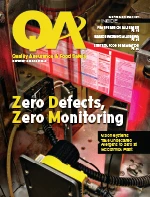 When dealing with stored product pests—beetles, moths, and weevils that infest and feed on stored grains and beans—it is important to understand that their survival instincts are based on millions of years of evolution and protection from predators.
When dealing with stored product pests—beetles, moths, and weevils that infest and feed on stored grains and beans—it is important to understand that their survival instincts are based on millions of years of evolution and protection from predators.
Thus, said David Mueller, president of Insects Limited, “Humans are not the enemy. We have been around only thousands of years.” Because the insects’ instinct is to hide where its predators, such as the wasp, cannot get to it, some stored product pests deposit their eggs inside the grains of food where they can grow and mature unharmed. Mueller spoke at the 2012 Fumigants & Pheromones Technical Conference in May, organized by Insects Limited and Fumigation Service & Supply.
The insects’ reproductive rate also can be protective, with females able to reproduce almost from the time they emerge. In fact, some females emit a male-attracting pheromone so powerful that the males are waiting outside the seed of grain for her to emerge. “The shorter the life of the adult, the more powerful the pheromone, because,” Mueller said, “they have to get it done.”
Once fertilized, some females will lay up to 100 eggs a night, up to 500 in her life. All stored product pests do not burrow into the grain to lay the eggs, some will simply find a flaw or minute hole in a package. With her keen sense of smell, the female is drawn by the odor emitting from the hole. “Insects live in a world of odors and lay their eggs on food packages which have defects,” Mueller said. If the hole to which the female has been drawn is too small for her to fit through, she will simply put her abdomen into it and lay her eggs.
Whether the eggs have been laid in the grain or in the package, they can go undetected while in a warehouse awaiting transport or in a store awaiting purchase. Then when the food is in a consumer’s pantry, the insects can begin to emerge. And the longer the product sits unopened or unused, the longer the insects will have to propagate and the greater will be the consumer complaint. “Customer complaints are often caused when the female insects lays her eggs on or near finished food,” Mueller said.
Most stored product pests can survive and breed at temperatures ranging from the mid-60s to the mid- to high 90s (Fahrenheit), explained Alain Van Ryckeghem, technical director for Insects Limited. Optimum temperatures for rapid reproduction and development tend to be around 90°F.
However, there are just as many variations between stored product pest species as there are similarities. Some can fly, others cannot; some are most active at dark, others both day or night; some are attracted to pheromones, others are repelled by excess pheromone, and still others are more attracted by foods.
Control. It is for all these reasons, distinctive characteristics, and habits of stored product pests that control is dependent on knowing the infesting insect, its habits and its tolerances. “Start with the insect first,” Mueller said. “Then develop a program that the insect can’t tolerate.”
Such a program, Van Ryckeghem said, involves five steps:
- Identify the insect. Misidentification can lead to use of inappropriate or ineffective monitoring and control strategies.
- Learn what it likes and dislikes. Knowing an insect’s food, temperature, and harborage preferences can help eliminate wasted inspection time, and increase the chances of discovery. Insects search for the ideal conditions on which to focus egg-laying efforts and increase reproductive success. Finding and manipulating these conditions will affect reproductive success and reduce future population growth or rebound—and mean greater management and control of the pests.
- Monitor with an appropriate trap. Appropriate trap types and pheromone lures are keys to successful monitoring. Monitoring data allows you to evaluate the effectiveness of management strategies by comparing the population activity before and after implementation.
- Take away what it likes. Removing the conditions that attract stored food pests or allow them to proliferate will reduce the opportunity and degree of infestation in stored food facilities. Lack of food, cool temperatures, and other factors that affect pest presence will put great stress on the population.
- Then … it must leave or die. Many pest infestations are in an isolated state, occurring, for example, within a package, pallet, room, building, or silo. If the infestation is stressed through manipulation of the environment, use of pesticides, or removal of food, the insects must search for new opportunities or die in that location.
Humans may be millions of years younger than stored product pests, but our own evolution and survival instincts have enabled us to combat these pervasive pests. For more on the evolution of technology against stored product pests, see From the Advisory Board, page 47.
The author is Editor of QA magazine. She can be reached at llupo@gie.net.

Explore the December 2012 Issue
Check out more from this issue and find your next story to read.
Latest from Quality Assurance & Food Safety
- Bird Flu: What FSQA Professionals Need to Know
- Registration Open for 129th AFDO Annual Educational Conference
- Frank Yiannas, Aquatiq Partner to Expand Global Reach of Food Safety Culture
- World Food Safety Day 2025 Theme: Science in Action
- Ancera Launches Poultry Analytics System
- USDA Terminates Two Longstanding Food Safety Advisory Committees
- Catalyst Food Leaders Announces Virtual Leadership Summit for People in Food
- Food Safety Latam Summit 2025 Set for Mexico City





